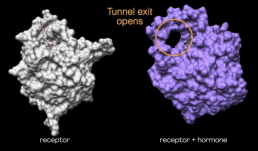Parasitic plants devastate entire fields of crops every year, resulting in billions of dollars of food lost. As food prices rise, protecting crops from parasitic plants is crucial to keeping meals affordable. Researchers at the University of Toronto have discovered a path to rescuing crops by finding an unexpected feature of the protein that leads parasitic seeds to sprout.
Healthy plants secrete a hormone called strigolactone. Hormone receptors in seeds of the parasitic Striga plant respond to this sign of abundance by activating the Striga seed to sprout. The parasitic seedling then infiltrates the roots of a healthy crop plant to steal its nutrients.
The shape of a receptor protein can change as it is activated, and knowing this shape helps design chemicals to block the receptor. All previous attempts to capture strigolactone bound to its receptor were unsuccessful.
Amir Arellano Saab in Prof Peter McCourt’s lab identified a number of receptor mutants that he predicted would capture the hormone. He worked with Dr Peter Stogios of BioZone to crystalize these purified proteins bound to hormone.
Arellano Saab and Stogios were excited to obtain crystals of high-affinity HTL5 receptor bound to strigolactone. They applied structural biology techniques and AI-powered molecular dynamics simulations to resolve the shapes inside the crystal.
As Stogios presented the result at lab meeting, his colleagues gasped in astonishment. They could clearly see a tunnel through the protein which wasn’t there if there was no hormone. The most likely role for this tunnel is to dispose of the hormone once it is processed.
Scientists will now be able to design chemicals to block the tunnel, preventing the sprout-promoting activity of the receptor. Striga is a frequent cause of crop loss in Africa, so this will greatly improve yields for African farmers in particular.
These results are published in the journal Nature Plants as “Structural analysis of a hormone-bound Striga strigolactone receptor”.

